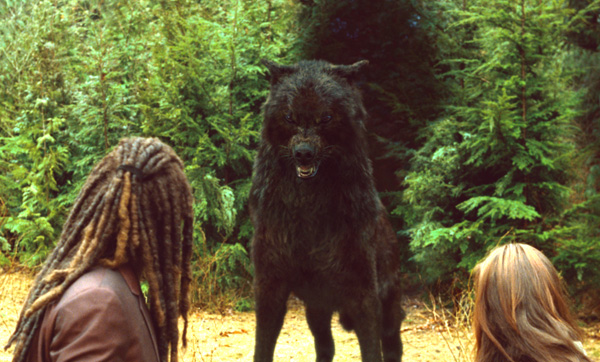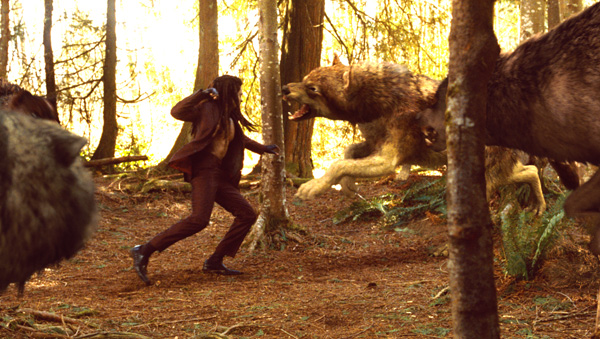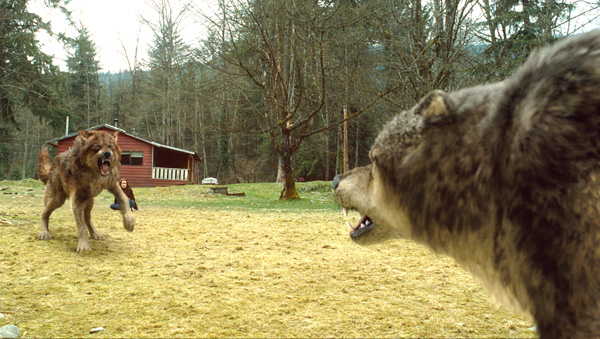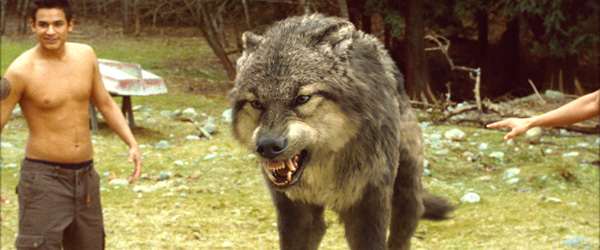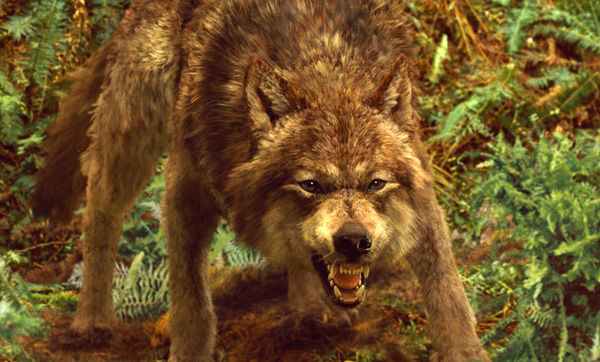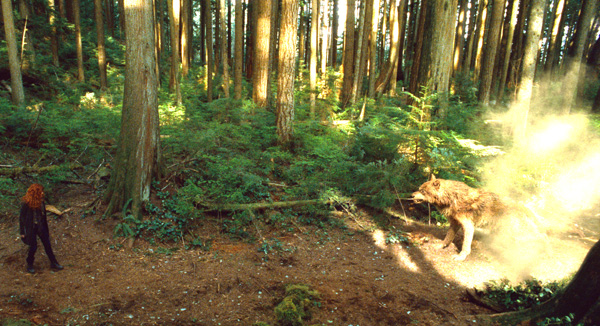|
VFX Supervisor for 'New Moon' Susan MacLeod had worked previously with Director Chris Weitz on visual effects for ‘Golden Compass’. She believes that the working relationship she and Chris have built, based on similar ideas and tastes about the use of effects in drama productions, helped make the very short time frame on ‘New Moon’ possible. Preproduction for Susan, including brief, storyboarding and previs ran only from early February to March 2009, when shooting started.
FX Blueprints
Fortunately, she also had some character animation experience behind her, which helped her develop the CG wolf characters with Tippett Studios. She contrasted their development with that of the vampires. “The vampire effects were subjective, not based on real-life creatures like the wolves. Chris and I developed the looks together and closely followed the ‘Twilight Saga’ books by Stephanie Meyer, anticipating the expectations of her huge fan base. Meyer made herself constantly available as a consultant to the team.”
A dedicated previs team created animated blueprints of all effects shots, which included camera moves and required elements. Susan worked with this team and then relayed the plans to Chris. Vampire effects, almost entirely carried out by Prime Focus in Vancouver, comprised a large chunk of the just over 400 effects shots required in total, and involved some experimentation.
Flame Apparition
When the lead character Edward leaves his girlfriend Bella behind in the conventional world to join his vampire family, for example, he continues to communicate with her. At these times, he appears in an apparition effect based on flames, created during compositing with eye-on Fusion and based on real, HD candle flame elements. These were enlarged or reduced in size, and slowed down to modulate transparency, displacement and softness. Fusion particles were used for the formation of the apparition and when it blew away again the effect was done with 3D particle simulations in 3D Studio Max.
Susan explained that this effect was made to replace Bella’s ability to hear Edward’s voice, as described in the book, with a visible effect. Because the shoot had to take place before the look had been fully developed, he was always shot on green screen for these scenes to give them complete control over the effect in post. He was either shot on location as a separate green screen element or they shot a location plate for him, shot him on green screen later and composited him in. In fact, most effects looks took some time to create and development continued to the end of post.
The effect’s development was carried out on test shots at the various locations. Even for these supernatural types of effects, they wanted to establish links to reality and the live-action. At first, Susan thought a good reference would be water, but Chris decided flames were more appropriate and they both collected a variety of flame references, which became the motion and softness references.
Complex Sparkle
Adding drama to the apparition sequences was a sparkling effect over Edward’s skin when he stood in sunlight, which turned out to be a complex process using several techniques. “Shots were match moved in Boujou and Syntheyes, with a lot of hand work in Maya. Sparkles and related elements were generated in 3D Studio Max,” said Eric Pascarelli, VFX Supervisor at Prime Focus. Shooting on film didn’t offer a wide enough brightness range to achieve the desired effect, so they had to apply lens effects, flares and light rays.
In addition, they had to give the skin a translucent glow. “We used 3D particle geometry dispersed over a CG model of Edwards’ head. Comping was done in Fusion using mostly built-in effects as well as a few of the Genarts Sapphire plugins used primarily to generate the ‘rays’ emanating from the sparkling particles," Eric said. "The process was surprisingly laborious, requiring lots of hand work to balance the elements in each shot because they were all so different. There really wasn't a plugin that could solve the problem except to generate elements that were manipulated by hand.”
Over the Edge
Prime Focus accomplished some complex ‘invisible’ enhancements requiring matte paintings made at the company’s Los Angeles location, green screen photography and set extensions. “For two cliff diving sequences, the actors were shot on a small set in a very controlled environment, and then composited into backgrounds shot at one location combined with cliff matte paintings based on a shoot from another location. It was quite a puzzle,” said Susan. The studio created digital doubles and face replacements for the actors jumping off the 70ft cliff.
Prime Focus also contributed CG water for several scenes, and the LA team created the movie’s Forks High School location as further matte paintings.
Some other action sequences needing complicated effects involved Bella on a motorcycle, deliberately putting herself at risk to invoke contact with Edward. One scene in which Edward appears to travel past Bella on her bike required a detailed previs organising Bella to drive the bike on a tow-rig while Edward, shot on green screen, would be added to the scene later. In another shot, in which her bike skids in front of a cinema, the tow-rig was used again and then removed during cleanup.
Under the Dome
Most of the filming was done in Vancouver, featuring a similar landscape to the story’s location in Forkes, Washington. Some scenes were shot in Montepulciano, Italy, when the action moved to the vampire’s other world. Susan worked on set through most of the shoot in both locations and with both first and second units. Only the first unit shot in Italy. The vampires carried on inside a large beautiful set of a classic Italian interior. Because its huge domed ceiling was never built physically, Prime Focus constructed a CG dome in 3d Studio max based on designs from the production art department. The art and effects departments maintained their own websites in order to share assets and designs.
The vampires maintain a violent and vicious hierarchy, culminating in several fight sequences. When they are injured, their skin cracks like marble. “Match-moving was employed and the crack was animated using traditional means - a frame-by-frame animation of crack art created by Susan Stewart in Prime Focus’ matte painting department," said Eric. "The healing process was animated in comp, again with Fusion, with displacement to heal the wound and a scar added underneath it. A marble floor cracking effect was done in 3D using a breakage simulation plugin to Studio Max. A bowling ball-like object was dropped on the floor to generate the simulated marble crack.”
Revolving Seasons
A very complex and time consuming shot to plan, shoot and post takes place in Bella’s bedroom set where she suffers from loneliness after Edward leaves her, a vision described at length in the novel. The camera circles around her as the seasons and time of day progressively change outside her window. The team had done a previs in pre production that gave them a blueprint. The set design had to be adjusted slightly to accommodate the shot.
“The 1080° pass with Bella in her chair and the interior of her room, including the window frames was shot on a set in a soundstage on a custom-made 8' diameter dolly track and PeeWee dolly,” Eric explained. "The dolly was encoded and the entire camera move was recorded into a Kuper motion control computer. The windows had no glass and green screen was placed outside the windows. Seasons were changed with lighting cues that happened while the windows were outside the frame.
Motion Control Rig
“The data from the dolly was translated to work on a Zebra motion control rig which was used to shoot everything that happened beyond the window glass. Three passes were shot separately, one for each season portrayed, from the vantage point of Bella's room on the exterior of her house set. The bay window was removed from the house to offer an unobstructed view of the outside. The art department redressed the outside for each of the looks, and different extras were used for each.”
The ‘December’ exterior was mostly replaced with a matte painting, which was more practical than trying to dress the entire exterior with snow. Only the areas where there was interaction with people were fully dressed with snow.
The comp was made more difficult by its sheer length, about 2,500 frames. Compositor Tim Jones, an Australian, worked for several months on it, smoothing the camera moves and adding the various elements to the mix such as CG window reflections and dirt, CG falling leaves and snow, and painstakingly painting out various objects on the walls as the camera rotates around and the room becomes barer over time.
Company of Wolves
The most spectacular and attention-grabbing effects shots in this film were a pack of enormous, entirely CG wolves who spend most of their lives as teenage high school students. It was an absorbing project for the effects team at Tippett Studios, not least because it required extensive research and referencing.
VFX Supervisor Phil Tippett said they found abundant information available on wolves, from documentaries to pictorial essays in magazines, but probably the most valuable research the team carried out was a trip to a wolf preserve near LA that his VFX co-supervisor Matt Jacobs organized for the animators, art department, TDs, compositors – anyone involved in putting the shots together. They all climbed into a 40ft pen with the wolves and spent the afternoon feeding, touching and walking around with the wolves, observing wolf behaviour first hand.
Inside Out
Matt and Phil wanted to build and animate CG wolves from the inside out. “Wolves are significantly different to domesticated dogs, and each belongs within a socialised ‘pecking order’,” said Phil. While the team took a few stills of their fur and recorded some mini dvds, the real value of the visit was gaining a sense of wolf psychology, an experience that no amount of study can replace.
Tippett prevised their wolf shots separately to the others that Susan oversaw, but she did help choose specific reference images for modelling the five wolves the script required. Susan had worked with Tippett before and thought the studio would suit the project. Historically and through their considerable growth and development into digital effects, Tippett have maintained a strong link to practical effects and live action footage. It is always present behind their CG work.
The character Sam is the ‘leader of the pack’ and the dominant male among the wolves. Two other characters operate just below him in the hierarchy, while two others play subordinate roles. All are the lupine counterparts of a group of tough young men who live outside Bella’s town and violently oppose the vampire clan who attempt to appropriate their territory. Battles ensue.
Window to the Soul
Director Chris Weitz wanted to give the CG wolves the eyes of their corresponding human characters as a separate effect, especially for shots in which the character Jacob watches Bella and we see her reflected in his wolf’s eye. His aim was to let their eyes serve as windows to their souls, inspired by the fact that real wolves communicate a great deal with their eyes, although Phil said he suspects the CG eyes could only have worked subliminally, “No one could have recognised those eyes so far out of context.”
Phil explained, “The eyes were not composited or tracked into the rest of the wolf body. That would have been much more trouble than it was worth – ‘prohibitively impossible’. The actor’s eyes were filmed as close ups, which were then used as reference when modelling the 3D wolves’ CG eye balls.” Tippett's building, modelling and rigging pipeline was based on Maya.
The CG wolves were very large, each the size of a small horse, and would weigh about 1200 lbs or 500kgs. The varying sizes of the different wolves are a clue to their human identities. As the largest man, for example, Sam became the largest wolf. His colleagues were sized accordingly, both as smaller humans and scaled-down wolf models. Coloration was another distinction. These differences will be useful to loyal ‘Twilight Saga’ fans: the wolves return as even stronger characters in the next film in the series, ‘Eclipse’, for which Tippett has already started filming.
Transformation
In the script, interaction between the wolves and humans was fortunately kept to a minimum. Nevertheless, Tippett devised methods of laying out the shots with full-sized wolf stand-ins alongside Director of Photography Javier Aguirresarobe. These gave the actors an eyeline to know where to look, and they rehearsed the scenes with them to make sure everyone stood in the right place relative to the wolves and the camera.
Rigorous preplanning gave all the actors confidence about where elements would be, and the fight sequences were choreographed with a well-worked previs of all the actions and specific camera moves. In fact, Chris sometimes wanted camera moves that were considerably faster than conventional dollies could provide. Special camera rigs had to be designed to pull back very quickly as the wolves were transforming.
Appropriate to the heroic, protective role they play in the story, these wolves do not follow a traditional tortured werewolf-style transformation from human to beast. The process occurs in mid-air, happening in an instant as the young men spring into action, and is triggered by anger. The major hurdle was working out how to effectively achieve the mass change from 160lb man to 1200lb wolf, without a silly-looking result. “The speed of these shots definitely worked in our favour,” said Phil. “In between some of the transformations, we used digital stunt doubles for a few frames.
The Only Option
“This transformation process and sheer size were the main reasons why CG was the only option for the wolves. There is nothing human about them apart from their eyes. They are totally animalistic creatures. Furthermore, real wolves cannot be trained to obey to behave predictably, nor could dogs resembling wolves have been used. When the required moves are so specific, you would have to resort to key frame animation with digital wolves.”
All wolf shots were done outdoors, without sets, and shot on 35mm film. Shooting began in March 2009 and shots were delivered in September. The shots were designed in Vista Vision, a higher resolution widescreen variant of the 35 mm motion picture film format. Owing to the shot designs, Phil didn’t want to be bound to a predetermined camera move. He wanted the animation to drive the camera, and so he chose a larger format camera that allowed post camera moves, thereby allowing the wolves to perform the way they wanted to perform and letting the animators go with it.
Creative Mistakes
“If you try to preplan things too much, say with a 4-perf camera – in this case a lot of the production was shot 3-perf – you have to be so precise that there’s no room for error," said Phil. "A great deal of the spontaneity of the performance comes from error. Because the camera operator cannot know what the wolves will be doing when he’s shooting the background plate, we have to allow for that. And with the speed at which you are shooting, you can’t experiment much. You have to move on, capturing whatever you might need. The previs helped us a great deal with the specifics for some shots. But you still want freedom beyond this, to be able to move beyond the conventional camera frame.”
The stunt coordinators, the DOP, Chris and Phil all set out the previs together. For example, as one of the actors leapt into the air, he was rigged on wires, appearing to leap 15 to 20 feet into the air, and was left hanging there, suspended at the moment he would phase into the wolf. He would then have to be erased, as well as all the wires holding him.
Credibility Factor
To help lend credibility to the transformation, the actor would perform a preliminary pantomime, shuddering and losing control just before he ‘pops’ in mid-air into his wolf character. This was a well rehearsed and timed choreography that Tippett devised to ensure that the final pose the actor performed would link smoothly with the action the wolf had to perform in the scene.
Further to the wolves, comprising 60 shots, Tippett completed 12 vampire shots requiring a ‘speed’ effect. For their transitions, footage was shot at 96fps. These frames were pulled, scaled and motion blurred, and various special effects or animation approaches were applied to leave a blurred effect, indicating that the vampires were moving in their supernatural ‘hyper speed’ mode. More such shots were completed by Prime Focus, allowing Tippett to focus on the wolves.
|
 Glittering vampires that shatter like marble and teenagers transforming into
Glittering vampires that shatter like marble and teenagers transforming into